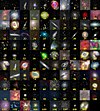NGC 147
| Galaxy NGC 147 |
|
|---|---|
![NGC 147 [1] amateur recording](https://upload.wikimedia.org/wikipedia/commons/thumb/7/77/NGC147.jpg/300px-NGC147.jpg)
|
|
| NGC 147 amateur recording | |
| AladinLite | |
| Constellation | Cassiopeia |
|
Position equinox : J2000.0 , epoch : J2000.0 |
|
| Right ascension | 00 h 33 m 12.12 s |
| declination | + 48 ° 30 ′ 31.5 ″ |
| Appearance | |
| Morphological type | dSph / dE5 |
| Brightness (visual) | 9.4 mag |
| Brightness (B-band) | 10.4 mag |
| Angular expansion | 13.2 ′ × 7.8 ′ |
| Position angle | 25 ° |
| Surface brightness | 14.5 mag / arcmin² |
| Physical data | |
| Affiliation |
Local group Andromeda subgroup Messier 31 group LGG 11 |
| Redshift | −0.000644 ± 0.000010 |
| Radial velocity | −193 ± 3 km / s |
| Absolute brightness | −15.5 mag |
| Dimensions | 10 8 to 10 9 M ☉ |
| diameter | approx. 10,500 ly |
| history | |
| discovery | John Herschel |
| Discovery date | September 8, 1829 |
| Catalog names | |
| NGC 147 • UGC 326 • PGC 2004 • CGCG 550-006 • MCG + 08-02-005 • 2MASX J00331212 + 4830314 • GC 72 • h 29 • DDO 3 | |
NGC 147 is an elliptical dwarf galaxy of the Hubble-type dE5 in the constellation Cassiopeia in the northern sky . The galaxy is an estimated 300,000 light years away from Andromeda (roughly the same distance as between the Milky Way and the Large Magellanic Cloud ) and is about 8,000 light years in size along its largest dimension. It is a companion galaxy to the Andromeda galaxy and, together with NGC 185, forms a gravitationally bound galaxy pair.
The supernovae SN 1954J (Type-IIP?) And SN 2002kg (Type-IIn?) Were observed here.
The object was discovered on September 8, 1829 by the British astronomer John Herschel . Belonging to the local group was confirmed by Walter Baade in 1944 when he was able to resolve individual stars with the 100-inch telescope at Mount Wilson Observatory .


